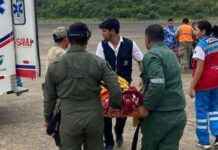Exhausted, lacking food, her tears, more and more rare, are only a tenuous moan.
“He’s the only child I have and he’s very sick,” says his mother Fadumo Daoud, contemplating her son’s skeletal legs and the food infusion taped to his nose.
To save him, she traveled three days from the Baidoa region in southwestern Somalia, the country hardest hit by the historic drought that is starving the Horn of Africa.
At De Martino Hospital in Mogadishu, Fadumo Daoud watches over his son day and night and prays that he will not be added to the hundreds of children who have died in recent months from malnutrition.
According to Unicef, 730 children died in nutrition centers between January and July. More than half a million, aged six months to five years, suffer from severe malnutrition.
After four seasons of failed rains since the end of 2020 and with a fifth one promising to be similar from October, Somalia is sinking inexorably into famine.
Across the country, 7.8 million people, nearly half of the population, are affected by the drought, of which 213,000 are in serious danger of starvation, according to the UN.
Without urgent action, a state of famine will be declared in the southern regions of Baidoa and Burhakaba between October and December, warned in early September the head of the UN Office for the Coordination of Humanitarian Affairs (Ocha) Martin Griffiths.
According to him, the situation is worse than during the last famine in 2011, which killed 260,000 people, more than half of them children under five.
– Exodus –
Faced with the dangers posed by the insurrection of radical Islamists Shebab which has shaken the country for 15 years, a million Somalis have left their villages for the big cities, in particular the capital Mogadishu, where they regroup in informal camps.
A mother of ten, Nuunay Adan Durow traveled 300 kilometers from the Baidoa region to seek medical help for her three-year-old son Hassan Mohamed, whose limbs had swollen due to severe malnutrition.
“For three years, we have not harvested anything because of the lack of rain,” she explains.
“We were faced with a terrible situation (…) To get a jerry can of water, you have to walk two hours”, continues this 35-year-old mother, cradling her son while waiting for treatment in a medical center in the NGO International Rescue Committee (IRC) in the outskirts of Mogadishu.
In the seven health and nutrition centers that the NGO runs in and around the capital, “the number of new arrivals has increased considerably since June”, explains Faisa Ali, nutrition manager at IRC.
Among them, the number of malnourished children has tripled, from a high of 13 a day in May to 40 in September.
– 5.8 kg at two years –
The drought has even hit traditionally fertile regions, such as Lower Shabelle, bordering Mogadishu. Once a refuge for communities hit by droughts, it is now deserted by its inhabitants.
“We used to grow and harvest vegetables to feed our children before the drought hit us,” said Fadumo Ibrahim Hassan, a widow and mother of six, a week after arriving in the capital. Now, “we live on everything that God gives us”.
The 35-year-old brought her two-year-old daughter Yusro to De Martino Hospital on the advice of IRC doctors who deemed her condition too serious.
The girl weighs just 5.8 kilograms, half the weight of a healthy child of her age.
Such cases are more and more frequent, worries doctor Fahmo Ali.
“Those we receive here are the worst cases, with complications”, she explains: “And sometimes, some that we have treated come back to the hospital, after falling ill again”.








